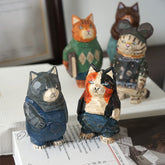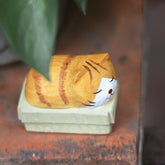Do You Really Need a Sharp Carving Knife for Wooden Gifts?
Once you’ve used a sharp knife to craft wooden gifts, you’ll never tolerate a dull blade again. A sharp knife lets you focus on your carving technique, while a dull one forces you to apply more pressure. The more force you use, the harder it is to control the knife—making it more likely to slip and increasing the risk of injury. That’s why sharpening your tools is not just important but an essential skill. It takes patience and technique, but I believe it’s just as crucial as carving itself. If done right, even an ordinary metal blade can become a powerful tool.

Two Things You Need to Know Before Engraving Wooden Gifts
Before sharpening, there are two key things we need to understand.
First, when does a knife actually need sharpening?
Second, what does a sharp blade look like—both visually and in use?
Let’s start with the first question.

Three conditions of a carving knife for wooden gifts
Your knife will generally fall into one of three conditions.
The first condition is relatively sharp, but you want it to be razor-sharp. The simplest solution is to use a strop to remove tiny debris from the blade’s surface.
The second condition is when the blade loses its sharpness and starts tearing the wood instead of cutting it cleanly. For example, take this knife—it can still cut through the wood, but you can feel a lot more resistance, and the surface isn’t smooth anymore. At this stage, a strop alone won’t be enough. Instead, we need to use fine sandpaper to sharpen the edge first before polishing it.
Keep in mind that sharpening has three key stages: reshaping, refining, and polishing. These first two conditions are relatively easy to fix and don’t take much time.

The third condition is more troublesome. The blade may have small chips or even a broken tip, which means you’ll need to reshape it completely. A chipped edge usually leaves visible scratch marks on the wood while carving.

Basic steps for sharpening
Take a look at this knife—you’ll notice a white line along the edge, which indicates a small chip. A broken tip is even more severe and requires reshaping.
To restore a damaged blade, start with coarse sandpaper or a rough sharpening stone, then move to a medium-grit stone, followed by a fine-grit stone, and finally finish with a strop. Completing the full sharpening process is the only way to fully restore the blade.

What kind of blade works best for carving wooden gifts?
Now, let’s talk about what a properly sharpened blade looks like. If you were to break the blade in half and examine the cross-section, a well-sharpened edge should look like the diagram in the middle—it has two straight lines that meet at a single point.

Over time, excessive stropping can cause the edge to curve outward, forming a rounded bevel instead of a precise cutting point. A properly maintained blade should have an ultra-thin, hair-like micro-bevel at the tip, followed by the main edge.

If you don’t sharpen your blade regularly or use improper sharpening techniques, stropping alone can gradually turn your blade into the open-ended shape shown on the right.
We’ve mentioned before that a knife blade works like a small wedge cutting into the wood. The thicker the wedge, the more it splits the wood apart rather than slicing through it. This is why the thinner the edge and the smaller the angle, the sharper and more efficient the knife will be.

That’s why a thinner blade with a smaller cutting angle always makes carving easier and produces cleaner results.











